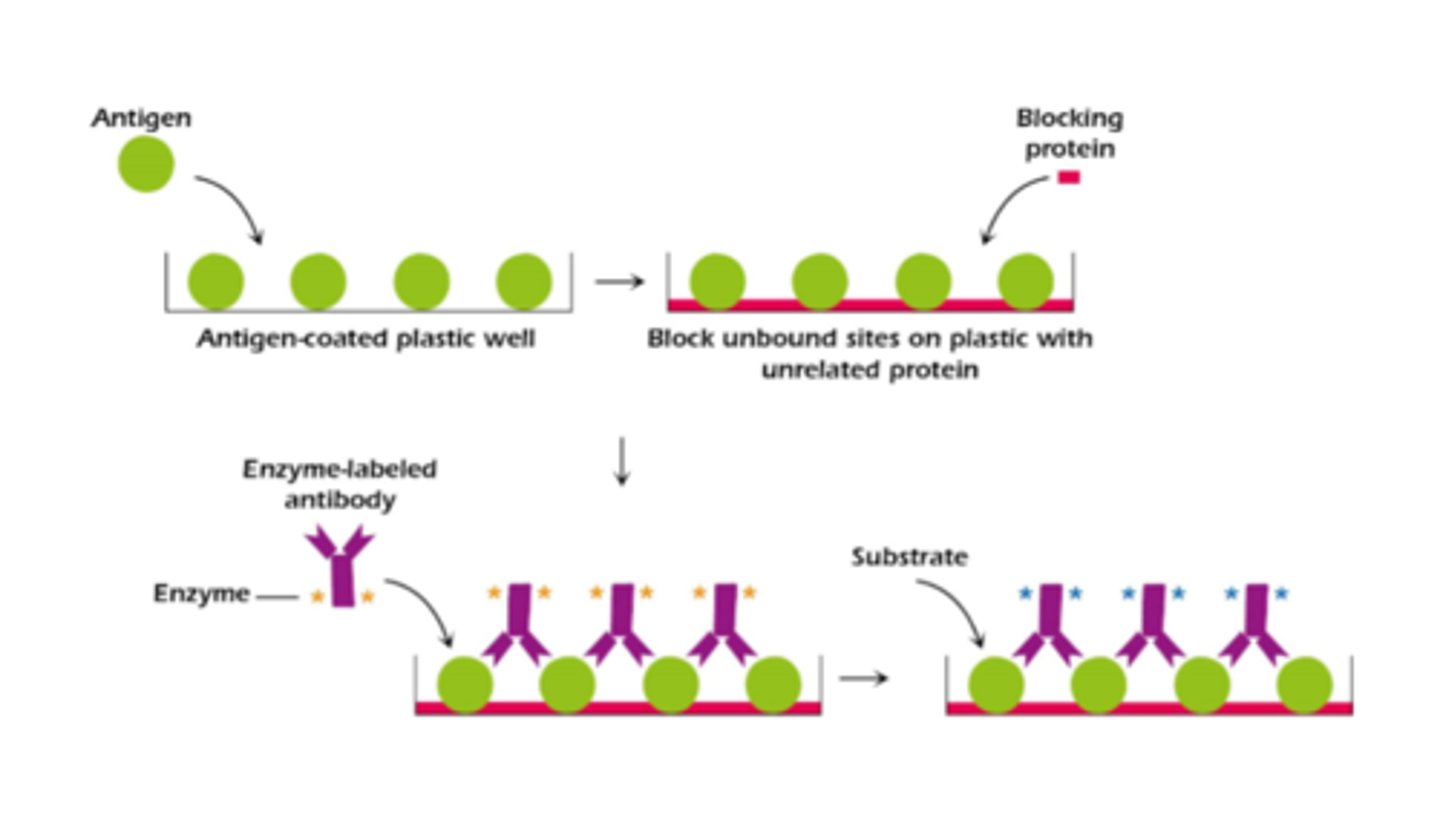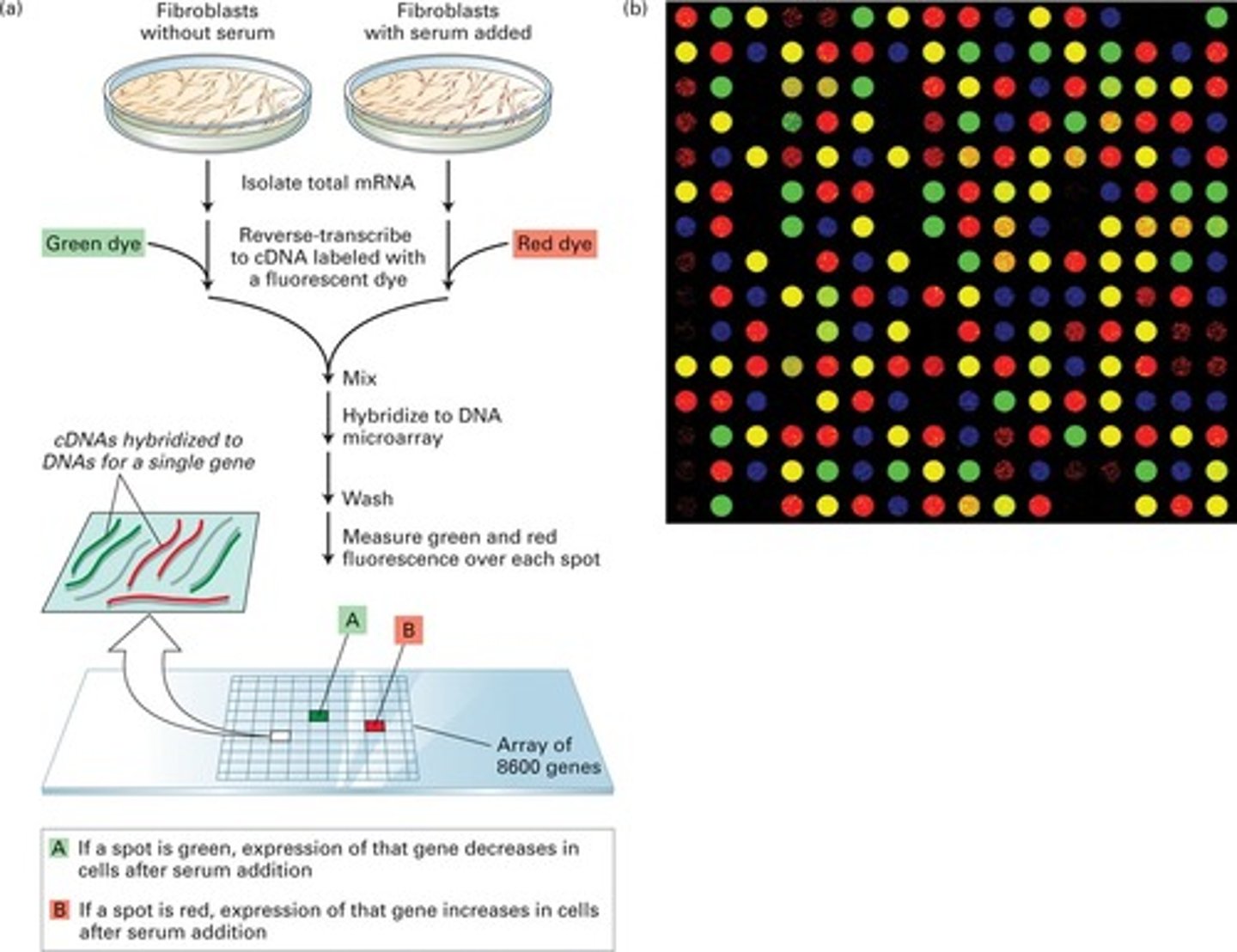Lecture 17 Antigen-Antibody Interactions Part 2
1/47
There's no tags or description
Looks like no tags are added yet.
Name | Mastery | Learn | Test | Matching | Spaced |
|---|
No study sessions yet.
48 Terms
Immunoassays
A procedure for detecting or measuring specific proteins or other substances through their properties as antigens or antibodies.
-Direct-Binding
-Solid-Phase
Radioimmuniassy
Permits measurement of extremely small amounts of antigen, antibody, or antigen-antibody complexes.
-Type of Direct-Binding immunoassay
-Isotypically labeled molecules
-Concentration is determined by measuring the radioactivity (very sensitive)
-Commonly employ rabbit antibodies to the desired antigens
-Tremendous application in hormone and other assays of substances found at low levels in biological fluids
-Not routinely performed
Solid-Phase Immunoassays
One of the most widely used automated immunologic techniques in clinical medicine.
-Uses various plastics to adsorb monomolecular layers of proteins (antigens) onto their surface.
-Chromogenic substrates are applied to wells in the plastic
-Wells containing enzyme-conjugated antibodies bound to antigen will show a color change.
-More intense color signifies the presence of higher concentrations of antigen absorbed into the well.

Adsorb
to hold or gather molecules of a gas, liquid, or solute on the surface of an object in a condensed layer
ELISA (Enzyme-linked Immunosorbent Assay)
A solid-phase immunoassay used to detect antigen-antibody complexes with the assistance of enzyme-conjugated anti-immunoglobulins and fluorescent substrates.
Two key features of solid-phase immunoassays
1. May be used to detect the presence of antibodies to the antigen that coats the plastic
2. May be used for the qualitative determinations of antigens
Immunofluorescence
A fluorescent compound has the property of emitting light of a certain wavelength when it is excited by exposure to light of a shorter wavelength
Direct immunofluorescence
Primarily for detection of antigen
-Involves reacting the target tissue/microorganism with fluorescently labeled specific antibodies
-Clinically used for identifying lymphocyte subsets
Indirect Immunofluorescence
Consists of two reactions:
-Primary unlabeled antibody interacts with antigen
-Secondary labeled antibody interacts with primary Ig
-More widely used than Direct
-A single fluorescent anti-Ig can be used to localize antibodies of many different specificities
Flow cytometric analysis and cell sorting
-Uses fluorescent antibodies specific for cell-surface antigens
-Instruments designed to =
--(analyzers) Measure the size, granularity, and expression of cell surface or intracellular proteins
--(cell sorters) Perform all of the functions of the analyzers plus sort cells into distinct populations
Flow cytometry
Uses differences in electrical conductivity between species or fluorescence.
Mainly used for clusters of differentiation (CD) antigen determination.
-CD nomenclature originates from monoclonal antibody studies
-Constellation of CD markers determines cell type
What are ways antigens and antibodies can be removed from each other?
-Antigens can be trapped and selectively removed form their antibodies in a mixture of additional antigens.
-Antibodies can be trapped and selectively removed from their antigens in a mixture of additional antibodies.
-Two general removal methods: immunoabsorption and immunoadsorption
Immunoabsorption
Absorption occurs with both reagents (antigen and antibody) interacting in soution
Immunoadsorption
Adsorption occurs when one reagent (antigen or antibody) is attached to a surface or insoluble support molecule
-blood plasma purification
Dry eye disease
a multifactorial disease of the tears and ocular surface, resulting in visual disturbance and tear film instability.
-Inflammation is a core mechanism in developing DES, identified by tear matric metalloproteinase 9 (MMP-9_
Cellular assays
experimental procedures used to measure and observe various cellular functions, behaviors, or responses in a controlled environment such as
-Lymphocyte function
-B & T-cell proliferation
-B-cell Antibody Production
-Effector Cells (T-cells and NK cells)
Lymphocyte function (cellular assays)
Assess whether B & T-cells respond normally to antigenic (mitogenic) stimuli by producing antibodies (B-cells) and cytokines (T-cells)
B and T-cell proliferation (cellular assays)
Mitogen-stimulated lymphocyte activation triggers cell proliferation. LPS will cause polyclonal stimulation of B-cells. Lectins stimulate T-cells.
B-Cell antibody production (cellular assays)
ELISAs are the most commonly used quantitative assays for measuring antibody levels
Effector cells (cellular assays)
T-cell assays are varied because of the number of functionally diverse T-cell subsets known to exist. CD8+ T-cells have cytotoxicity assay. NK cells have antibody-dependent cell-mediated cytotoxicity (ADCC) assays.
Cell culture
Knowledge of the growth factors required to maintain lymphoid cells has made it possible to clone and grow functionally-competent cells in vitro.
-B-cell Hybridoma/ Monoclonal Antibody Technology
-Recombinant DNA technologies
B-cell Hybridoma/ Monoclonal antibody technology
Research in the 1970s that led to the development of the first successful cell culture systems
Recombinant DNA technologies
-Recent advancements that permit the transfer of genes to clones lines for further study
-Led to the development of genetically engineered immune molecules and receptors
What is the purpose of primary cell cultures?
Primary cell cultures are essential investigational tools that help understand the developmental, maturational, or physiological properties of cells.
What happens during the transformation of B and T cells?
Transformation of B and T cells from specific parent cells results in cloned, immortal cell lines.
What can cause the transformation of B and T cells?
Carcinogen or viral exposure can cause transformation, such as:
-B-cell transformation with Epstein-Barr virus
-T-cell transformation with T-cell leukemia virus type I
What is a major advantage of cell transformation?
A major advantage of cell transformation is the ability to generate large numbers of cells.
What is a major disadvantage of cell transformation?
A major disadvantage is that the transformation renders cells abnormal.
How can T-cell lines be grown indefinitely?
T-cell lines can be grown indefinitely when interleukin-2 is included in the culture along with a source of antigen and antigen-presenting cells.
Monoclonal antibodies
Homogenous populations of antibody molecules derived from the progeny of a single antibody-producing cell. All antibodies are identical and have the same precise specificity for a given epitope.
How are most monoclonal antibodies made?
in mouse cells
-Antigen administered to mouse subjects
-Developed B (plasma) cells are extracted
-B (plasma) cells are fused with myeloma (tumor) cells
-Forms a hybridoma cell population
-All produced antibodies from the hybridoma cell population are identical and have the same specificity.
What is a complication of administering mouse monoclonal antibodies to humans?
The patient will form antibodies to the mouse immunoglobulin (anti-immunoglobulin).
Have in vitro human monoclonal antibodies been successful?
No, in vitro human monoclonal antibodies have not been successful.
What are two genetic engineering technologies used to produce human monoclonal antibodies?
-Recombinant DNA: Produces chimeric mouse-human monoclonal antibodies called humanized antibodies.
-Polymerase Chain Reaction (PCR): Generates heavy and light chain gene libraries from hybridomas or plasma cells.
Is genetic engineering of immune proteins limited to monoclonal antibody production?
No, it is not limited to monoclonal antibody production.
What is a costimulator receptor, and how is it used in genetic engineering?
A costimulator receptor (e.g., B7 family) is transferred to tumor cells, enhancing the ability of T-cells to recognize and kill those tumor cells.
Inbred stains
-Animal subjects like mice, rats, and guinea pigs
-Selective breeding= 20+ generations leads to an inbred strain
-All members of an inbred strain are genetically identical (syngenic)
-Knowledge of transplantation laws and the existence of MHC molecules came from inbred straining experimentation
Adoptive Transfer
-Protection against many diseases is conferred through cell-mediated immunity by antigen-specific T-cells
-Adoptive T-cell transfer
-Passive T-cell transfer
Adoptive T-cell transfer
performed using genetically identical donor and recipient cells (inbred strains)
-Results in long-term adoptive immunization
Passive T-cell transfer
Performed by transferring serum-containing antibodies to the target across MHC barriers
-Effective as long as transferred antibodies remain active in the recipient
-This type of transfer is also called passive immunization
SCID Mice
-Severe combined immunodeficiency disease is a disorder where B & T cells fail to develop
-Individual has compromised lymphoid defense mechanism
-SCID-human chimera mice make B & T
Nude Mice
-Fail to develop a functional thymus
-Homozygous recessive nude gene mutation also leads mice not to develop a thymus
-T-cell development can be restored by grafting thymic epithelial tissue
Transgenic mice
Made by injecting a cloned gene (transgene) into fertilized mouse eggs and then transfer them to pseudopregnant mice.
-Used to study genes that are not usually expressed in vivo (like oncogenes or particular)
-Entire mouse Ig genes have been replaced with human Ig genes to generate "human" antibodies in the mouse
-Low success rate: 10-30% of offspring express the transgene
-Disadvantage of the transgenic method is that the transgene integrates randomly within the mouse genome.
Gene-targeting methods
-gene addition
-knockout mutation
-Knock-in mutation
Gene Addition
specific insertion of a gene via CRISPR Cas-9 technology
Knockout mutation
replacement of normal gene with one that has been mutated or disrupted
-knockout mice express transgenes that integrate at specific endogenous zones through homologous recombination
Knock-In Mutation
Insertion of a protein-coding cDNA sequence at a particular locus in an organism's chromosome
-Mouse embryonic stem cells are easily manipulated
-Knock-in mice have target insertion of genes at specific loci, unlike transgenic mice
Microarrays (gene chips)
Examine the expression of thousands of genes simultaneously
-Comprises thousands of unique DNA fragments (complementary DNA or cDNA) orderly attached to a glass slide
-Messenger RNA from a cell or tissue is tested against a reference sample to compare gene expression among the cDNA fragments
-Samples added to the microarray are not mRNA but reverse-transcribed cDNA labeled with fluorescent material
